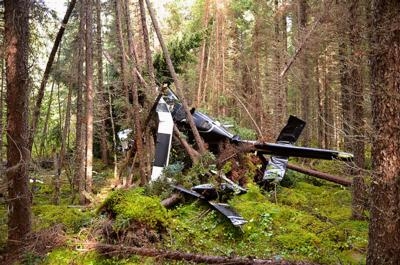Engine Power Loss Resulting From Low-Fuel Operation Led To To The Accident, Board Says
In its recently-released investigation report (A16W0126), the Transportation Safety Board of Canada (TSB) indicates that the absence of a company policy on landing with a specified minimum quantity of fuel was a key factor in a survey helicopter's loss of power and collision with trees near Whitecourt, Alberta, in 2016.

On 5 September 2016, a Ridge Rotors Bell 206B Jet Ranger helicopter was operating a daylight flight to survey mountain pine beetle with the pilot and two surveyors on board. While flying 160 feet above ground, the helicopter suddenly lost engine power and, within seconds, descended and collided with trees. The surveyor sitting in the front was fatally injured when trees penetrated the cockpit, while the other surveyor seated in the back sustained minor injuries. The pilot received serious injuries. The helicopter was substantially damaged.
The investigation established that, during a short rest break on a sand bar prior to the accident, the pilot decided to continue with the flight instead of refueling at a nearby fuel cache. The remaining fuel was close to the minimum recommended quantities to ensure appropriate safety margins against temporarily uncovering boost pump inlets, exposing them to air. Ridge Rotors' practice of regularly operating helicopters with low fuel levels likely influenced the pilot's decision to continue the flight.
Moments before the accident, the helicopter entered a left turn, and the resulting acceleration forces likely resulted in air entering the fuel pumps, interrupting fuel flow to the combustion chamber, which led to the engine power loss. The company used automatic ignition systems only in snow conditions. Consequently, the system had not been turned on in the occurrence aircraft. The investigation concluded that low altitude survey work in combination with low fuel levels and the inactive automatic ignition system contributed to the inability to recover from the engine power loss.
It is important for operators to understand the limitations of the Bell 206B helicopter fuel system and the risks associated with flights conducted with less than 20 US gallons of fuel. If operators do not observe the minimum fuel quantities recommended in the flight manual, there is a risk that the helicopter will be operated at fuel levels conducive to engine power loss.
As this occurrence demonstrates, some operators are not managing safety risks effectively. This operator and many others are not required to have a formal safety management system (SMS) in place. The TSB has repeatedly emphasized the advantages of an SMS, recommending that Transport Canada require all commercial aviation operators in Canada to implement a formal SMS (A16-12). To date, the Board has been unable to assess Transport Canada's response to this recommendation because Transport Canada has not specified the actions that will be taken to implement a formal SMS. Safety management and oversight is on the TSB Watchlist.
Transport Canada conducted a process inspection of Ridge Rotors after the accident, and the company subsequently implemented corrective action plans to address TC's minor findings of non-compliance. The company has also incorporated changes in its standard operating procedures and trained pilots accordingly.
(Source: TSB news release. Image from report)
 NTSB Prelim: Piper PA-23
NTSB Prelim: Piper PA-23 Classic Aero-TV: One Mans Vietnam
Classic Aero-TV: One Mans Vietnam NTSB Final Report: Capella Aircraft Corp FW1C50
NTSB Final Report: Capella Aircraft Corp FW1C50 Classic Aero-TV: Timber Tiger Touts Curtiss Jenny Replicas
Classic Aero-TV: Timber Tiger Touts Curtiss Jenny Replicas ANN's Daily Aero-Term (07.04.25): Performance-Based Navigation (PBN) [ICAO]
ANN's Daily Aero-Term (07.04.25): Performance-Based Navigation (PBN) [ICAO]



